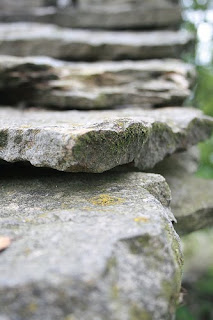
I´ve always been fascinated with the cabaña pasiega in Cantabria thier simplicity, thier remote locations, green pastures, the history of the Pasiego dairy farmers, and their
stoneness...a lot of rock: walls, roof shingles, stairs. At any point in a mountain hike in Cantabria you´re bound to visit one of these beacons of isolation lost in the highest mountains and wonder, how the hell did this get here--while in other parts of Spain you´re liable to run into a Christian hermitage up in no-man´s land...here it was all about the cows and pasture.
But what really sparked my obsession were two things: their abundance, spotted along the Cantabrian landscape; and of course, their price tag: 10, 20 or 30 thousand euros for two 45 square meter stories and several acres of land. With or without electricity, running water, an accessible road or just a small foot path. And I thought, hey, I could swing that.
Anytime I would spot one of these stone cabins on my many hikes, my imagination would fly: imagine taking a long hike and ending up here, at your own cabaña, with wood to start a fire to cook on, sit and relax on your stone door steps, drinking from you wine boot while looking out to absorb the mountain landscape. The night bonfire, a hot evening meal...and then waking up the next morning with Amaia in a silent morning mist, only hearing cowbells and smelling the wood smoke from the chimney. Working out in the garden, thinking you have the whole day up here to take a hike, a dip in a stream, and not just a few hour hike, which was our customary escape from the overcrowded, concrete city.
So as it ends up, we´re going to buy one, in Miera,
under Monte Enguinza, overlooking the Cantabrian Sea and Santander´s sandy beaches. But, besides mustering up the courage to do so, besides digging deep in our pockets, convincing my wife to go along with my bucolic fantasy, and withstanding the confused look on people´s faces when I told of my plans, the hardest part still remains: La Reforma.
Through this blog I hope to document and share the process, doubts, reflections and pictures, and also hope to get some help in solving some of the obstacles I will face by having a space to discuss this adventure with both the internet audience and my friends who will partake in this project helping me both physically in the labour, and intellectually with ideas and motivation to keep going.
Let the fun begin.









